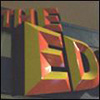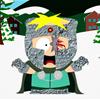Ask the Experts / Real-World area equivilancy
-
 11-January 04
11-January 04
-

 flmscor
Offline
What are some estimates as to how much space one square on the RCT grid represents in the "real world"? I'm guessing about 100 square feet, or about 10'x10'.
flmscor
Offline
What are some estimates as to how much space one square on the RCT grid represents in the "real world"? I'm guessing about 100 square feet, or about 10'x10'.
Any thoughts? -
 v1perz
Offline
It seems like a person can walk a square in a few steps, so id say about 8' by 8' or a little less.
v1perz
Offline
It seems like a person can walk a square in a few steps, so id say about 8' by 8' or a little less. -

 deanosrs
Offline
Well, if you really want to know enough you could work it out cos it tells you how many acres your park is somewhere.
deanosrs
Offline
Well, if you really want to know enough you could work it out cos it tells you how many acres your park is somewhere.
I, however, cannot be arsed. -

 Lucifer
Offline
In RCT:LL Steve Franks (correct me?) worked out 1 RCT square is 10ft square. However - with the "realistic height" introduced in rct2, i believe that changed slightly.
Lucifer
Offline
In RCT:LL Steve Franks (correct me?) worked out 1 RCT square is 10ft square. However - with the "realistic height" introduced in rct2, i believe that changed slightly.
-

 flmscor
Offline
do you mean 100 feet sqaure? 10 feet square means that each side of the square is 3.33 feet long. Which, in turn means that all those single tile shops and other objects are only three feet across.
flmscor
Offline
do you mean 100 feet sqaure? 10 feet square means that each side of the square is 3.33 feet long. Which, in turn means that all those single tile shops and other objects are only three feet across. -

 Koaster Kid
Offline
Now I see where you come up with that '100 feet'.
Koaster Kid
Offline
Now I see where you come up with that '100 feet'.
I think he means 10' by 10' which is what you were saying in the first place. Am I correct? -

 Coaster Ed
Offline
I haven't played RCT2 enough to know what the scales are or what's been changed. I have seen quite a few "educated guesses" at the scale of a space in RCT1 over the years though and I can tell you that none of them work. They don't work because the scales in the game don't agree with each other. Some people look at how the drop height calculated by the game matches with the height markers. Others look at the speed and length of coasters. Others look at the height of the peeps. None of these methods agree with each other so you always have several versions of what the height of your coaster might be depending on what you use to calculate it. It should be easy to program a simple equation so that all of these facts agree but for whatever reason, Chris Sawyer didn't bother to do this. I think there was something about the game equating meters to feet as well. Anyway, it's a game so everything has been simplified and skewed. You have to make up your own reality.
Coaster Ed
Offline
I haven't played RCT2 enough to know what the scales are or what's been changed. I have seen quite a few "educated guesses" at the scale of a space in RCT1 over the years though and I can tell you that none of them work. They don't work because the scales in the game don't agree with each other. Some people look at how the drop height calculated by the game matches with the height markers. Others look at the speed and length of coasters. Others look at the height of the peeps. None of these methods agree with each other so you always have several versions of what the height of your coaster might be depending on what you use to calculate it. It should be easy to program a simple equation so that all of these facts agree but for whatever reason, Chris Sawyer didn't bother to do this. I think there was something about the game equating meters to feet as well. Anyway, it's a game so everything has been simplified and skewed. You have to make up your own reality. -

 Lucifer
Offline
Lucifer
Offline
Maybe i havn't been paying attention in Math...In RCT:LL Steve Franks (correct me?) worked out 1 RCT square is 10ft square. However - with the "realistic height" introduced in rct2, i believe that changed slightly.


-

 Maverick
Offline
1 square in RCT2 is 10.4ft x 10.4ft or approx 108.25ft²
Maverick
Offline
1 square in RCT2 is 10.4ft x 10.4ft or approx 108.25ft²
I simply used 2 maps, one owned 256x256 squares, the other owned 254x254
256 map
- 7096760ft²
- 2664ft x 2664ft
- 2664/256 = 10.4ft
254 map
- 6983680ft²
- 2642.7ft x 2642.7ft
- 2642.7/254 = 10.4ft -

 Coaster Ed
Offline
Alright so according to those stats one square is 10.4 feet. Now build a coaster track that only goes traight and see what the claculated length is and I bet you'll get a different number.
Coaster Ed
Offline
Alright so according to those stats one square is 10.4 feet. Now build a coaster track that only goes traight and see what the claculated length is and I bet you'll get a different number. -

 Maverick
Offline
From his original post it looked like he was asking for land area... from personal experience, I've learned that track sections are more like 12-13ft per block.
Maverick
Offline
From his original post it looked like he was asking for land area... from personal experience, I've learned that track sections are more like 12-13ft per block. -

 Adix
Offline
Each level is 4/3 of a meter... each sublevel is 1/3. For coasters, I go by speed, it seems to fit the scaling best.
Adix
Offline
Each level is 4/3 of a meter... each sublevel is 1/3. For coasters, I go by speed, it seems to fit the scaling best. -

Silenced Offline
If you dont go by speed your coaster is insanely fastEach level is 4/3 of a meter... each sublevel is 1/3. For coasters, I go by speed, it seems to fit the scaling best.

-

 flmscor
Offline
Thanks for all the great replies! I do have a recreation in mind, but mainly i'm just trying to establish a sense of scale in my work in general. to me RCT is like building a scale model, and I like to have my scale models... to scale.
flmscor
Offline
Thanks for all the great replies! I do have a recreation in mind, but mainly i'm just trying to establish a sense of scale in my work in general. to me RCT is like building a scale model, and I like to have my scale models... to scale. -

 mantis
Offline
Dude, you're a composer! You do what I wanted to do for quite a while (until I got sidetracked)! I always thought it'd be cool doing music for films and features and things - is it hard thinking up original things?
mantis
Offline
Dude, you're a composer! You do what I wanted to do for quite a while (until I got sidetracked)! I always thought it'd be cool doing music for films and features and things - is it hard thinking up original things?
(sorry to hijack your topic and stuff, but i'm just interested )
)
-

 Coaster Ed
Offline
I find it best to work in terms of stories for building scale. If you figure you can place one window per tile horizontally, and one height level is one story, than you can get a pretty accurate representation of building sizes. For coaster recreations, I base everything off the inversions in the game because RCT has it's own scale and peculiarities. You take the coaster layout - say Riddler's Revenge for example (very hard to recreate well) - and based on the number of invrsions and the speed that the coaster will need to make it through all of those, you determine the height. This usually ends up being just high enough for the coaster to enter the first big loop at about 60mph. For small loops it's about 40mph and for corkscrews it's about 35mph. I know people have their own preferred numbers for these, but those have always worked for me. For coasters without inversions then, I would scale those based on the looping coasters. If a coaster is 200 feet, guess that a B&M looper would be about 160 feet so the scale between them is 5:4. There's a judgement call involved here as to what you think looks the best in the game. It's more complicated than just applying a direct number for the scale, but I think recreations done in this way will look more correct in the game perspective than anything based on the numbers. Cause, as I said before, the numbers don't add up.
Coaster Ed
Offline
I find it best to work in terms of stories for building scale. If you figure you can place one window per tile horizontally, and one height level is one story, than you can get a pretty accurate representation of building sizes. For coaster recreations, I base everything off the inversions in the game because RCT has it's own scale and peculiarities. You take the coaster layout - say Riddler's Revenge for example (very hard to recreate well) - and based on the number of invrsions and the speed that the coaster will need to make it through all of those, you determine the height. This usually ends up being just high enough for the coaster to enter the first big loop at about 60mph. For small loops it's about 40mph and for corkscrews it's about 35mph. I know people have their own preferred numbers for these, but those have always worked for me. For coasters without inversions then, I would scale those based on the looping coasters. If a coaster is 200 feet, guess that a B&M looper would be about 160 feet so the scale between them is 5:4. There's a judgement call involved here as to what you think looks the best in the game. It's more complicated than just applying a direct number for the scale, but I think recreations done in this way will look more correct in the game perspective than anything based on the numbers. Cause, as I said before, the numbers don't add up.
Maybe I should post a short blurb on recreations sometime because I've been looking at park recreations for years and could point people towards what I think are the best examples of park recreations in RCT.
PS - I'm at USC right now so it's cool to see someone coming out of there who's been succesful. And good luck with your recreations/parks in the future.
 Tags
Tags
- No Tags
